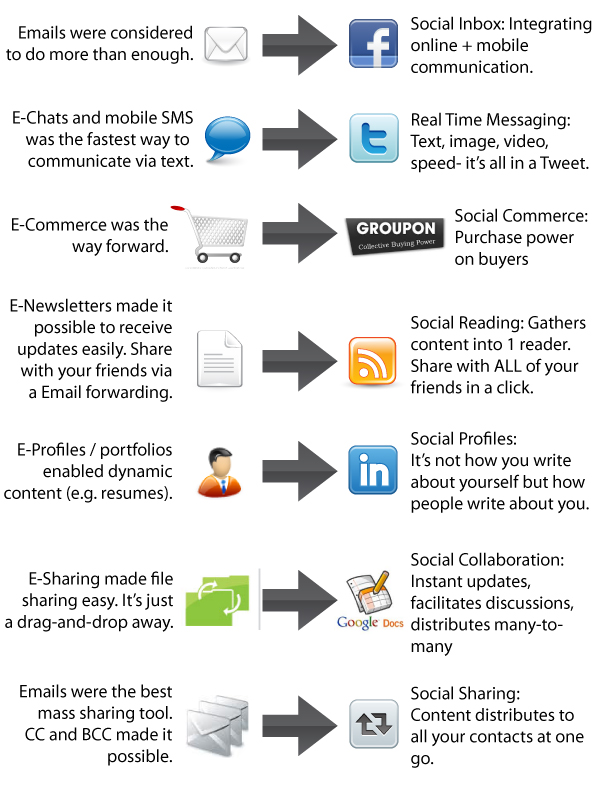5 Reasons Why #SocialMedia Contradicts Conventional Media Marketing
The more I dive deeper into social media, the more I see how different is marketing today compared to before with the usage of various social media tools and platforms. The conventional way of ‘mass marketing’ or ‘mass advertising’ don’t seem to work that effectively anymore and even some small business owners are beginning to explore this new ‘thing’ called social media.
Before we go further, there’s this VERY interesting video on YouTube that you HAVE TO watch:
Interesting huh? With those thoughts on your mind, here are the 5 reasons why social media marketing contradicts conventional marketing methods:
#1: Conventional Marketing Says TALK. Social Media Marketing Says LISTEN.
Just like the video above, conventional marketing does all the talking and they’ll just go on and on to promote their products and brand just like how this sentence will go on and on without any punctuations and you’ll have to read the entire sentence in one breath and yet it still does not end because they’ll want you to buy and if you don’t they’ll keep talking and talking.
In other words, it’s just a ONE way relationship. Consumers today respond better to conversations. Remember, a conversation is TWO way. Before you click that “update” button, think – will YOU as a consumer respond to a post / update / tweet like that? How does that reflect you as a business? Is it too pitchy? Are you giving an opportunity for your followers to respond?
#2: Conventional Marketing Says KEEP. Social Media Marketing Says SHARE.
Content used to be exclusive. My research is mine. My video is mine. My article is mine. My statements are mine. Can’t blame them though, there isn’t any content sharing platform back then. However, such content were considered as trade secrets and even employees are not told of it.
Today, social media marketing is all about sharing. It is about getting as many people to share the message as possible. Call to actions are no longer limited to “Enter Your Email to Win Prizes” but to “Share This With As Many Friends As Possible to Win”. Companies are even creating content solely for sharing purposes – through SEO (you want to share your content), viral videos, contests and more!
 #3: Conventional Marketing Says SELL. Social Media Marketing Says GIVE.
#3: Conventional Marketing Says SELL. Social Media Marketing Says GIVE.
Conventional marketing focuses on the money. You have to pay if you want something from me. Makes sense, right? However in social media marketing, it’s all about giving, and believing in the philosophy of ‘givers gain’. Giving does not necessarily mean money, but VALUE. This can be done through information, service, support and even conversations to keep that relationship with your consumers alive.
#4: MONEY Determines Conventional Marketing. ENGAGEMENT Determines Social Media Marketing.
The rich becomes richer and the poor poorer in conventional marketing. Big corporations have millions of dollars every year to put up huge marketing campaigns with their brand plastered on every wall, ceiling, car and walkways, so much so that it feels as though they dropped a bomb in a city and yes, they do get the word out rather effectively – with a lot of money.
Not so on social media platforms. Money helps, but it does not necessarily produce results. The engagement and relationship speaks louder on social media. Think about it – what is it that really makes a content viral? The content? Or the consumers? The consumers make it happen. Yes, you can purchase fans and followers but that is equivalent of hiring a delivery boy to hand out your flyers and that does not go very well on social media.
This is where smaller businesses stand a chance against the big guys.
#5: Conventional Marketing Says QUANTITY. Social Media Marketing Says QUALITY.
Now this is an interesting one. Many have spoken on this before and I, too have written an article about quality isn’t exactly everything on social media networks (yes, I believe quantity matters, too!). However when it comes to conventional marketing, quantity ALWAYS matters. Think about it: the number of flyers, brochures, airtime, commercial spots, newspaper advertisements, coupons to giveaway, buntings, billboards… you get the drift.
Social media marketing on the other hand, aims for quality. Quality articles that educates, quality fans and followers that become your brand advocates, quality updates to drive conversations and quality conversations to build relationships.
Moving Forward
Recently I met with a potential client that just could not comprehend why would people blog to share personal / company information, update their status so that others would know what they’re up to and ‘check-in’ so that people could stalk them. He knows he needs to ‘do’ social media but just can’t get the reason why are people so into it.
Having looked at all that, it is clear that social media marketing really DOES NOT make sense to a conventional marketer. If you’ve been wondering why is it so difficult to convince an “experienced” marketer in your company (or client) to adopt social media methods, it is because it does not make sense to them.








 Gone were the days that you can simply start a business website, ignore the customers and yet make sales. With social networks kicking in, the news can travel within literally a click of a button.
Gone were the days that you can simply start a business website, ignore the customers and yet make sales. With social networks kicking in, the news can travel within literally a click of a button.  While that seemed common back then, it is a whole new world today.
While that seemed common back then, it is a whole new world today. 





 Recently I have been invited to the
Recently I have been invited to the 

